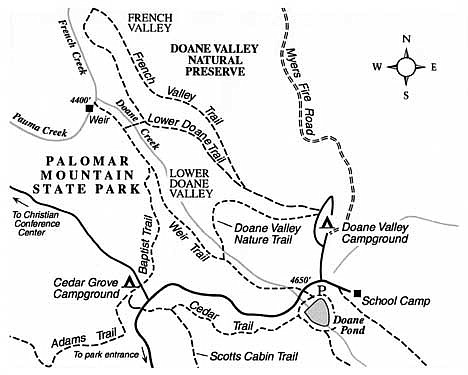 Facebook
Facebook
 X
X
 Instagram
Instagram
 TikTok
TikTok
 Youtube
Youtube
Mile-high Palomar Mountain State Park has probably the finest montane scenery in San Diego County, complete with trickling streams, mixed oak-conifer forests, and rolling meadows. So far, this magnificent spot has managed to evade the reach of catastrophic wildfire. The stomach-churning drive up Palomar's South Grade and East Grade roads is well worth the trouble once you get out of the car and start breathing in the sweet, tangy air.
This easy tour of Palomar's Lower Doane Valley and French Valley is good to explore first. Start walking at the large parking lot at Doane Pond, which is located about two miles beyond the state park entrance. Pick up the Doane Valley Nature Trail, following Doane Creek downstream. Along the bank grow box elder trees, creek dogwood, wild strawberry, mountain currant, and Sierra gooseberry -- uncommon flora for such a southern locale. You sidle by a massive incense-cedar tree towering well over 100 feet, easy enough to mistake as a sequoia redwood.
After 0.3 mile, the nature trail curves and climbs around a hill to connect with Doane Valley Campground. That's the way to go for a quick return, but for a longer (three-mile) walk, stay left and continue on the Weir Trail. Ahead you follow Doane Creek through white fir and incense-cedar forest. Continue to a confluence of streams, where Pauma Creek, flowing lazily at this time of year, sets a course down a hidden canyon toward Pauma Valley -- the valley of the San Luis Rey River.
There's a small weir just below the confluence, plus the remains of a stone-and-mortar gauging station used in the late 1920s to evaluate the hydroelectric potential of the stream. Today, the silted-in dam holds barely enough water to soak your feet in, and the flow of water -- while enchanting to the eyes, ears, and skin -- seems entirely insufficient to turn a turbine and generator.
From the weir, backtrack 0.2 mile on the Weir Trail, and take the short trail on the left that crosses Doane Creek. Hook up with the French Valley Trail and ramble northward into French Valley. The setting is idyllic: rolling grasslands dotted with statuesque pine trees, surrounded by hillsides clothed in oaks and tall conifers.
Several of the tree trunks are riddled with holes -- some plugged with acorns. This is the handiwork of the acorn woodpecker, who uses the holes to store acorns filled with larvae. The birds retrieve these acorns and the grubs in leaner times. Listen for the repetitive, guttural call of this bird, and observe the distinctive red patch on its head and the white wing patch when in flight.
Circle about on French Valley Trail to traverse back across Lower Doane Valley, and head for Doane Valley Campground, which is near your starting point. Return by way of the Doane Valley Nature Trail -- especially if you've managed to obtain an interpretive leaflet for that trail.


Mile-high Palomar Mountain State Park has probably the finest montane scenery in San Diego County, complete with trickling streams, mixed oak-conifer forests, and rolling meadows. So far, this magnificent spot has managed to evade the reach of catastrophic wildfire. The stomach-churning drive up Palomar's South Grade and East Grade roads is well worth the trouble once you get out of the car and start breathing in the sweet, tangy air.
This easy tour of Palomar's Lower Doane Valley and French Valley is good to explore first. Start walking at the large parking lot at Doane Pond, which is located about two miles beyond the state park entrance. Pick up the Doane Valley Nature Trail, following Doane Creek downstream. Along the bank grow box elder trees, creek dogwood, wild strawberry, mountain currant, and Sierra gooseberry -- uncommon flora for such a southern locale. You sidle by a massive incense-cedar tree towering well over 100 feet, easy enough to mistake as a sequoia redwood.
After 0.3 mile, the nature trail curves and climbs around a hill to connect with Doane Valley Campground. That's the way to go for a quick return, but for a longer (three-mile) walk, stay left and continue on the Weir Trail. Ahead you follow Doane Creek through white fir and incense-cedar forest. Continue to a confluence of streams, where Pauma Creek, flowing lazily at this time of year, sets a course down a hidden canyon toward Pauma Valley -- the valley of the San Luis Rey River.
There's a small weir just below the confluence, plus the remains of a stone-and-mortar gauging station used in the late 1920s to evaluate the hydroelectric potential of the stream. Today, the silted-in dam holds barely enough water to soak your feet in, and the flow of water -- while enchanting to the eyes, ears, and skin -- seems entirely insufficient to turn a turbine and generator.
From the weir, backtrack 0.2 mile on the Weir Trail, and take the short trail on the left that crosses Doane Creek. Hook up with the French Valley Trail and ramble northward into French Valley. The setting is idyllic: rolling grasslands dotted with statuesque pine trees, surrounded by hillsides clothed in oaks and tall conifers.
Several of the tree trunks are riddled with holes -- some plugged with acorns. This is the handiwork of the acorn woodpecker, who uses the holes to store acorns filled with larvae. The birds retrieve these acorns and the grubs in leaner times. Listen for the repetitive, guttural call of this bird, and observe the distinctive red patch on its head and the white wing patch when in flight.
Circle about on French Valley Trail to traverse back across Lower Doane Valley, and head for Doane Valley Campground, which is near your starting point. Return by way of the Doane Valley Nature Trail -- especially if you've managed to obtain an interpretive leaflet for that trail.
